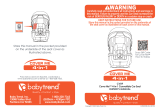To prevent serious injury or death:
• Use ONLY the vehicles Lap/Shoulder
Belt system when restraining the child
in this booster seat.
• Shoulder belt MUST be properly
positioned over shoulder (NOT
touching child’s neck and NOT low
off shoulder).
• Lap/shoulder belt MUST be properly
positioned exactly as shown in
illustration.
• NEVER position belt under child’s arms
(fig. a). Remove all slack from shoulder
belt.
• Never use a vehicle “lap-only” belt or
LATCH across front of child.
• DO NOT allow child to slide down in
car seat which could position lap belt
across child’s abdomen and shoulder
belt over neck or face.
• If child will not keep vehicle shoulder
belt properly positioned, DO NOT use
this booster car seat. Use a different
child restraint system.
• Vehicle belts MUST lay flat against child
and MUST not be twisted.
WARNING
14
Remove harness system (see “Harness System -
removal and re-assembly”, page 20).
Place child in car seat with child’s back flat
against back of car seat.
Place shoulder belt across child’s chest and
lap belt under both armrests.
Buckle belt and pull shoulder belt to adjust lap
belt snugly.
Shoulder belt MUST lay across child’s shoulder
in red zone as shown (fig. b). If outside of
red zone, see next steps for Comfort Clip
®
use.
CAUTION:
Some shoulder belts with (emergency
locking) retractors allow a child to pull belt
out and change position of belt. Use of
Comfort Clip
®
helps prevent child from
pulling belt out.
Thread shoulder belt through Comfort Clip
®
exactly as shown and hook end of Comfort
Clip
®
through desired loop of webbing (fig. c).
Check to be sure shoulder belt is properly
positioned over shoulder in red zone and snug
against child.
1
2
3
4
PLACING CHILD IN CAR SEAT - without harness system
5




















